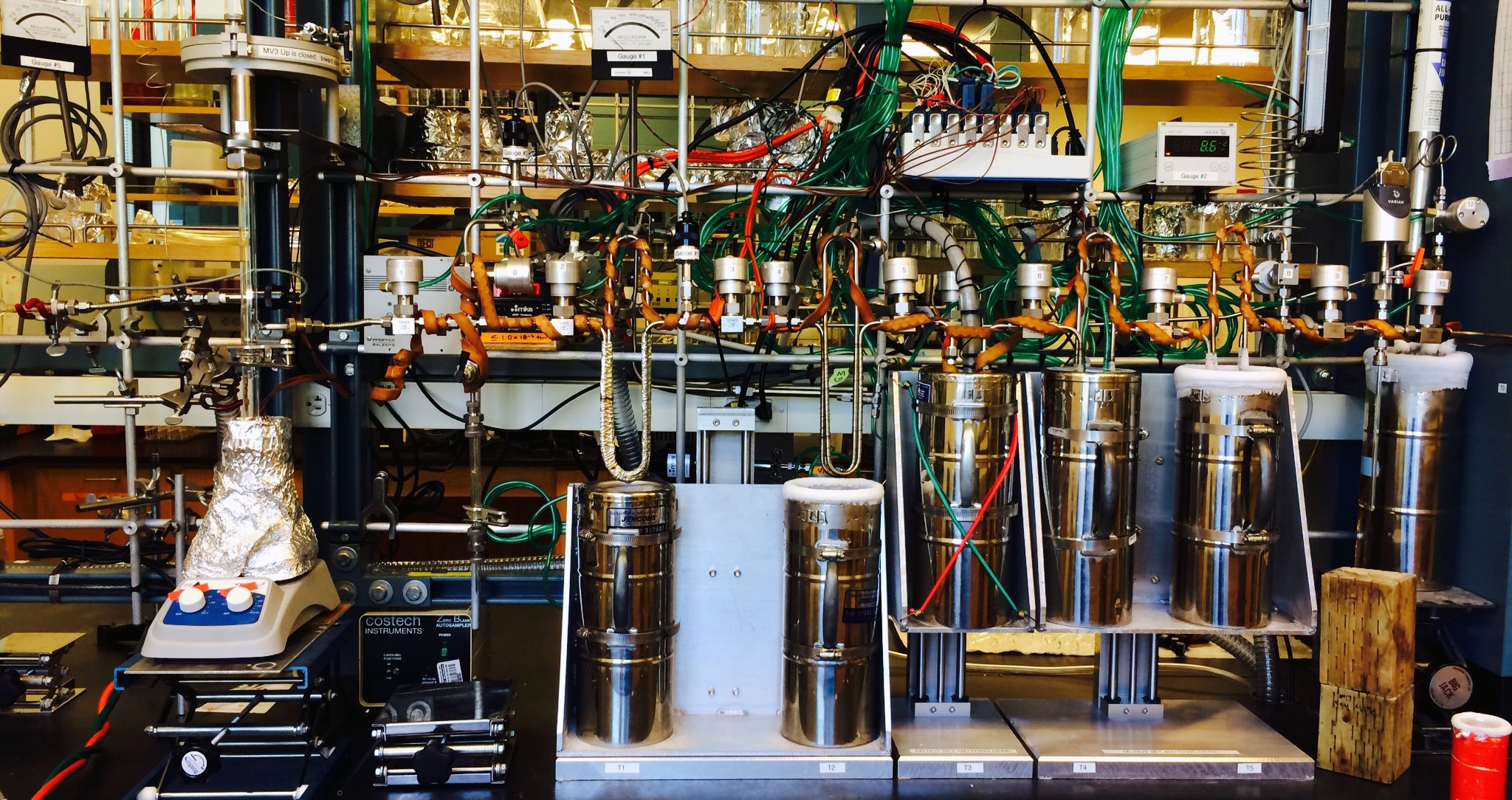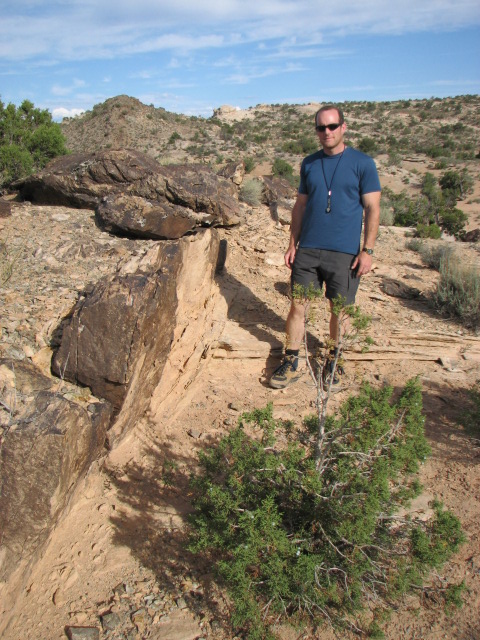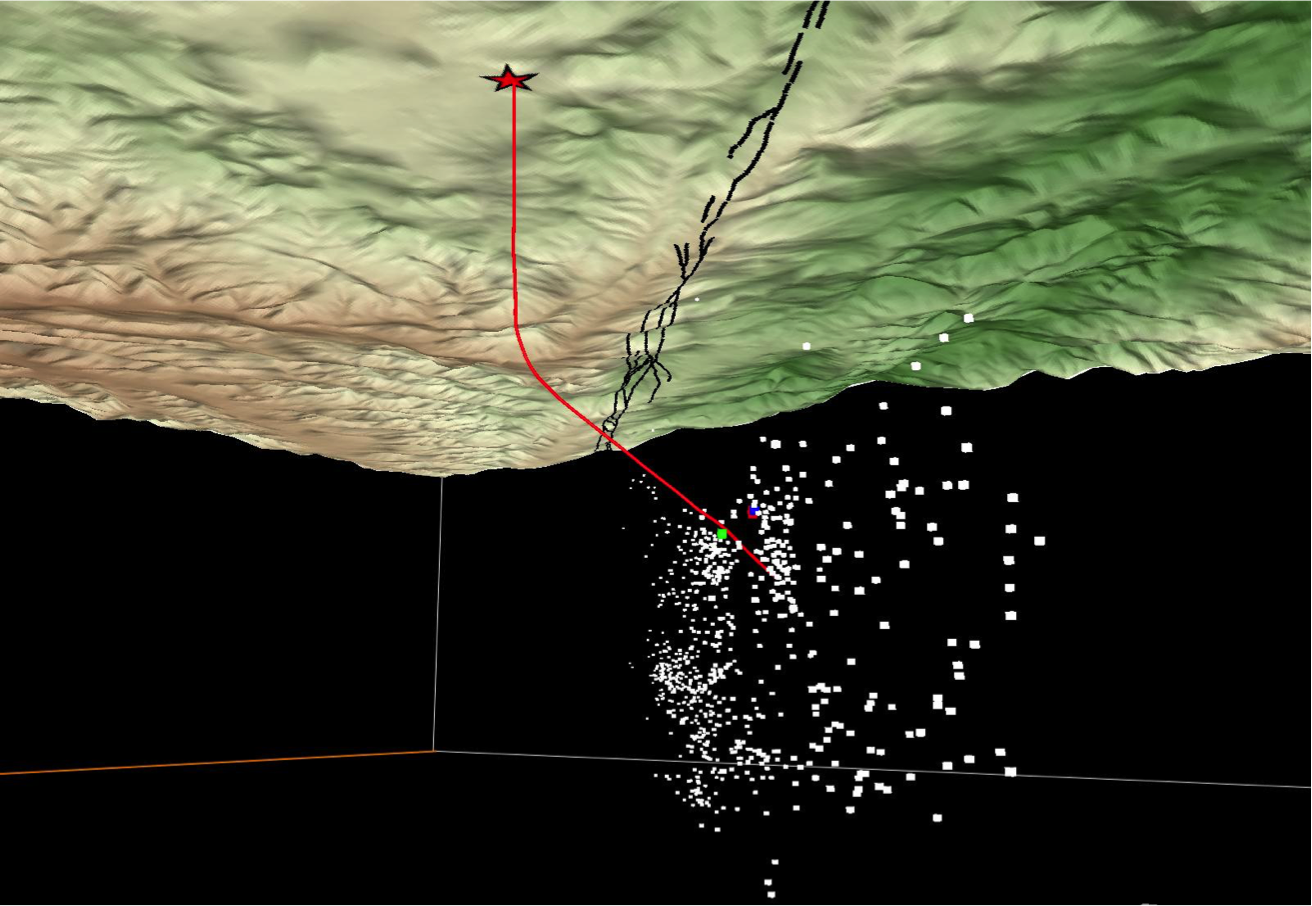Looking up from below and northward along the San Andreas fault zone in the vicinity of the SAFOD core. The drill site, marked by a star, is projected on the green and tan ground surface. Multiple strands of the San Andreas fault are mapped with black lines. The red path of the main SAFOD line intersects the fault at depth, where numerous earthquakes (shown as white balls) happen continuously. (Image from L. Blair, U.S. Geological Survey)
-by Sara Tewksbury
When looked at in three dimensions, the San Andreas fault near Parkfield, CA is lit like a Christmas tree hung with glowing orbs that represent earthquakes of different magnitudes at different depths. The reason the fault is so lively at this site has inspired many scientists over the decades to explore what the fault looks like below the surface. Through the years, EarthScope’s San Andreas Fault Observatory at Depth (SAFOD) has revealed a variety of new insights into fault behavior. Among them is the role that water plays in making rocks weak in a stressful environment. Water is a key player in how easily a fault may slip, and the SAFOD site is ideal for studying its role because the fault slips there fairly regularly.
Now, using new analyses from SAFOD cores, researchers have discovered potential sources of the fluids in the San Andreas fault that may be a key component to understanding how earthquakes happen there. Using a recently developed technique called clumped isotope thermometry, geoscientists from four different universities worked together to analyze SAFOD core samples from almost four kilometers (two and a half miles) deep. They found that the fluids within the fault zone may actually trickle down from the surface, navigating a network of fractures in the rocks and forming veins along the way. The veins tell the story of the water’s origins, which are reported in a recent issue of the journal Tectonophysics.
“It is exciting because we’re taking fault rocks from an actively deforming fault at depth and applying a new method for the first time to those rocks, to figure out the source and pathways and reactions. Then we try to put those observations into the context of the community’s evolving thinking of how faults and fluids have all these various ways of interacting,” says Katharine Huntington, an associate professor at University of Washington and co-author on the study.
How fluids weaken rocks in a fault zone
Scientists have long known that the San Andreas fault—the infamous boundary between the North American and Pacific plates—is weak, but have not yet narrowed down the exact cause (or causes) for the weakness. Still, all hypotheses point to fluids within the fault zone somewhere, because fluids are important determinants of rock strength. Ben Luetkemeyer, a recent Ph.D. graduate of Saint Louis University and lead author on the study, equates fluid-enhanced fault slip to navigating an icy sidewalk. “As soon as you lean back on your heels you slip. The San Andreas fault moves and is barely leaning back on its heels. SAFOD is especially interesting because it is located along a section of the fault that appears to be gliding,” he says.
Luetkemeyer, Huntington, and their collaborators focused on determining where those fluids in the fault zone came from and how they filtered through the damaged rocks. “Where we have a lot more to learn is precisely how those complex fault and fluid interactions work,” remarks Huntington.
When fluids interact with rocks, the original minerals can be transformed into other mineral types that slip easily, like the platy mineral serpentine or the soft mineral talc. This basically causes the fault to be more slippery, leading to earthquakes happening with greater ease.
“It’s this really rich and complex interaction between the fault zone and the fluids from both the mechanical and chemical aspects,” says Huntington.

Photo of “Polly,” the clumped isotope thermometry setup in the lab of Katharine Huntington at University of Washington. (Photo by K. Huntington)
Where did the fluid come from?
How fluids react with rocks is dictated in large part by how hot they get as they flow through. Clumped isotope thermometry offers the perfect approach for determining the fluid’s temperature during its trip through the fault. The technique—which has been applied to Earth Science problems for about 10 years—relies on the fact that a particular isotope of carbon hangs out with a particular isotope of oxygen within a crystal lattice as dictated by the surrounding temperature. The method was originally created to examine rocks at Earth’s surface, so using the approach to plumb the depths is also novel. “We’re really at the tip of the iceberg for applying this technique to subsurface applications,” says Huntington. “I think the tool is really a great one because we can see the context of where the minerals formed in the fault zone. We can see the fault fractured and grew and we can learn about the history of how it grew.”
Previously, scientists would have to make an estimate of temperature for fault-zone fluid in order to determine its composition. Now, using the clumped isotopes method, they know that the veins grew from fluid that ranged from 81˚ to 134˚ celsius (~180–270˚ fahrenheit) and that the fluid did not originate in rocks of the fault zone.
The mineral that fills cracks along the San Andreas fault is calcite, which is made from carbon and oxygen and is the perfect cocktail for the isotopic method.The temperature and composition results showed that some of the fluids that deposited the calcite were cooler than the surrounding temperature at depth within the fault zone. One explanation could be that the fluids at depth came originally from precipitation at Earth’s surface, also known as meteoric water, that trickled down the fault from above.

P. Benjamin Luetkemeyer stands next to an outcrop of rocks that are sheared along the San Andreas fault. (Photo by D. Kirschner)
Infiltrating an underground network
Knowing the source of fluids within the San Andreas fault has implications far beyond helping to determine the fault’s characteristics. One is the simple geometry of fluid pathways in the crust. Studying the network of calcite-filled fractures near the fault revealed different isotopic compositions on either side, indicating that the fault acts like a barrier, not allowing fluids to pass from one side to the other. This information will be taken into account in future models that seek to explain the mechanics of the San Andreas fault.
The second implication has to do with how fluids of any sort travel the underground fracture network. Rather than simply saying “water,” scientists use the term “fluid” because what flows in the cracks in the ground can be carbon dioxide, fresh meteoric water, and any contaminants within. Where do these different fluids normally reside at depth, and how do they interact with each other and the surrounding rock? Answers to these questions have implications for how we approach storing our excess carbon dioxide emissions underground, known as carbon sequestration.
“If we want to reduce CO2 in the atmosphere without stopping burning fossil fuels, our only recourse right now is to sequester CO2 in geological formations underground,” comments Huntington. “We want to know how to do it, and where it's going to go when we inject it in the subsurface.”
There seems to be no end to the possibilities in exploring underground water movement. Huntington and fellow scientists also work with geothermal systems to trace the fluid network, and their research has implications for finding subsurface fresh water, petroleum, and ore deposits.
“It is really exciting that with developing and applying these new methods, we can start to understand a range of problems from fluid–fault interactions to finding resources to mapping geothermal reservoirs and where contaminants spread underground,” says Huntington.
For now, they are just scratching the surface.
This study was conducted by the following authors, with funding provided in part by NSF grants EAR-0643223, EAR-0643339, EAR-0643027, EAR-0454527, EAR-1156134.
P. Benjamin Luetkemeyer, Ph.D. 2017 from Saint Louis University; now with Terracon Consultants, Inc.
David L. Kirschner, recently of Saint Louis University, now with Shell International Exploration and Production.
Katharine W. Huntington, University of Washington.
Judith S. Chester, Texas A & M University.
Frederick M. Chester, Texas A & M University.
James P. Evans, Utah State University.





